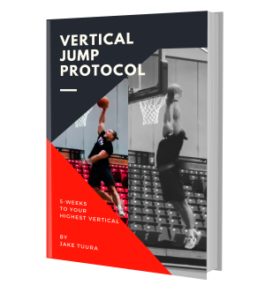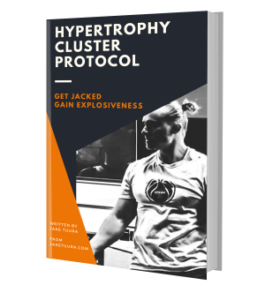Jumper’s knee: “I tried everything. And the basic thing was stretching, rest. And they published something. It is called Gua Sha. It’s from traditional Chinese medicine. And you take a very soft stone and you scrape over your tendon. I bought this stone online. I did this.”
“When someone reached out to me with a patellar tendinopathy, it was always the same sad story. Yeah, I developed it. In the beginning, it was no problem. After the warmup, it went away. Then it stayed for the training session. Then the pain was higher afterwards the next day.”
“In the early stages of tendinopathy, the pain goes away with a warm-up. These warm-ups could be different things… and then I think it was Rio came up with the 45 seconds [isometrics], but only to decrease pain, not like to have the solution for the underlying mechanism.”
“The long isometric holds, the decline squat, slow tempo, heavy, slow resistance training, and the Berlin method. These were the cornerstones.”
45 second isometric holds: “They said more or less 70 % of your maximum voluntary isometric force. So this is something when you compare this to the physiological knowledge that we have about tendons, then it can’t be something that triggers an increase in tendon stiffness or collagen synthesis.”
45 second isometric holds: “It was submaximal to trigger this warm up phenomenon. But also an anecdotal thing is that you have to be careful when you decrease the pain and then you train afterwards with decreased pain. It’s easy to overload the tendon even more, even if you want to do good for the tendon.”
Slow, heavy resistance: “You have to avoid bouncing out of the bottom position.”
Powerlifter with jumper’s knee: “We prepared him to squat 300 kilograms, so he was pretty strong. And I remember that we were way above 200 kilograms already in training, like 240, 260 kilogram, I can’t remember. And then, only then, I reintegrated the Berlin method with him, and that triggered, like he didn’t have pain for a long time, like several weeks, but this triggered the pain again. And that was when I realized, the Berlin method was actually researched on healthy tendons. And it is simply a very good way to increase stiffness of healthy tendons. But you have to also be careful with these high intensities with ⁓ pathological tendons, with tendinopathy.”
“I did regular bilateral decline squats with a barbell on the back, not single leg decline squat. The single leg decline squat was just a pain provocation test.”
Beginning tendon training: “So I started with the Berlin method in a way where you could guarantee that we start somewhere too low. For example, I usually start with three sets of three repetitions of these three seconds on, three seconds off, but maybe somewhere between 70 and 80%. And if this is OK and they tolerate it and the next day no increased pain, then we progress from there. And we progress first with volume, then we decrease the volume again when we increase the intensity. So a very logical approach. And that works very well.”
“When you work with professional, high level athletes, actually it’s more about managing the tendinopathy and not so much rehabilitating it. That is possible maybe in the off season.”
“I thought the sand is very forgiving… When I developed patellar tendinopathy, like sprinting on concrete. But it’s still very, very present in beach volleyball, patella and quadriceps tendinopathy.”
Heel elevated wall sits: “If you move your heels super close to the wall and stand on your toes and the heel touches the wall and then you squat down, then you come into more like a, what is it, like a sissy squat version a little bit. So your knees coming in front of your toes. And actually I enjoy this very much as a warmup exercise to trigger this or an early rehab exercise because that’s like one step further than the wall set and even the single leg wall set.” I really enjoy it and I think it’s a very good thing. But I ⁓ only incorporated it for a couple of weeks.”
Loading but not overloading the tendon: “I’m trying to find stimuli which are maybe fresh for the athletes… if I go on the pendulum squat and let them do it slowly, then it’s usually not triggering the tendon at all. Because of the knee angle, because of the speed, you can’t use as much weight as you would, for example, in a half squat. And so it’s a lot less strain of the tendon.”
Volleyball: “Our main currency, you could say, is jump height and we are pretty good at it, but it’s a very delicate balance between performance output and overloading it.”
“It’s gonna be the heavy things or the fast things and probably the things that they’re really skilled at that that’s how they’re gonna be overloading the tendon. So putting them on putting them on something slow and they’re not used to and then the pendulum squat makes a whole lot of sense.”
“I observed that deep knee angles were triggering the quadriceps tenonopathy more. But at the same time, you could argue maybe then you need to go into these deep knee angles, but in a systematic approach to strengthen the structure.”
“There is no research about beach volleyball players developing quadriceps tendinopathy. But I think it is the way they jump in the sand. It’s not a reactive way in track and field or indoor volleyball. They are not jumping in the sand, they are more like stepping very shallow into the sand and then pushing upwards. And I think something in there triggers more quadriceps telanopathy because actually a high percentage of the players have it. And with them, I avoid deep knee angles if the tendon is easily irritated.”
Squatting shallower with quadriceps tendinopathy: “So I actually try to put something under their butt. So we usually use these big medicine balls, these slam balls. And then we put maybe one or two plates underneath it. And so we try to find a restriction where we can clearly say, hey, this knee angle feels good. It’s not triggering anything. And then we work with there.”
Shallower squats with quadriceps tendinopathy: “I saw this is a method where we still can train heavy. So I have the adaptations hopefully there. What means adaptations at least keeping their output levels or performance level as high as possible from a neuromuscular standpoint, not so much from a tendon standpoint. And can we can train there intensively, but we’re not triggering anything.”
Tendon loading rate with a bouncy squat: “When you bounce in, then for a split second, the force is super high… And this is what actually overloads the tendon, the strain is for a short amount of time, maybe above 9 %.”
“In beach volleyball, it’s a little special because you don’t have the super bouncy reactive type of athletes because the sand usually kills reactiveness. So you have a lot less usage of the calf muscles and Achilles tendon. You don’t attack the ground from above.”
Flywheel training: “I think it can trigger tendinopathy. Not only trigger, it can develop the tendinopathy. But here’s the thing, the physiology behind it is pretty clear. If you use the K-Box and you don’t use it in a way where you have a true supramaximal eccentric overload… then I don’t see any reason why this should overload the tendon because physics, know, like the energy you give into the system is the same energy that you get out. And yes, the flywheel is pulling you down. So it forces you somehow down, but it’s not like a supramaximal stimulus and there’s evidence to it.”
“The sand is compliant. It is some kind of plyometric, but not in the way we usually think about, depth jumps, drop jumps, track and field, hurdle jumps. But still, you put a lot of force onto the tendon. There is strain, stress and strain, definitely. And it’s high volume because maybe it’s in the sand. The sand has different qualities. There can be very hard sand. And if it was raining, then the sand is actually super heavy and not compliant. And so I think it’s more of an overall volume thing, like how many jumps you did. I always compare, like I play a little bit of beach volleyball myself, and you can actually play beach volleyball for three hours. And three hours with just having a sip of water, You play and you play, your legs get tired, your muscles get tired, but your tendon, you don’t feel like you played three hours straight… I think it’s more the overall volume that you can use.”
Ankle dorsiflexion restriction: “It is like a decline squat. It’s like a decline squat. You stay with your heels in the air and then it’s transferred to the knee directly. And it will show in the knee, tendinopathy, maybe cartilage problems and so on.”
“You won’t find a single study about quadriceps tendinopathy and beach volleyball players on different sand surfaces and so on. But with the experience I have and with the athletes I worked with and not having a lot of quadriceps tendinopathy, I think it is this unique jumping approach in the sand you have. It’s more like a very shallow placing the foot onto the sand, sliding over it, and then you try, because it is so soft, you try to make it more dense and you have the whole foot on the sand in one, yeah, in one, and not diving into it with your toes first or the ball of the foot first and so on. And this is why you actually eliminate the Achilles tendon. It is already in a dorsiflexed position a little bit. That’s one thing. So you eliminate the calf and it’s natural, I would call it natural function. So maybe that’s one reason why you have more torque in the knee.”
Patella strap: “There is a reason why so many NBA athletes and players have it and use it and indoor volleyball players. If somehow these 17 000 fibers of the patella tendon get less stress with a strap because it adjusts somehow how the patella is pulling on the tendon or so. Okay take it.”
Jonas on Instagram: https://www.instagram.com/kukfrankfurt/
Jumper’s Kneehab Programm: https://myablefy.com/s/kukfrankfurt/jumpers-kneehab
Jonas on YouTube: https://www.youtube.com/channel/UCbyoRiUmk1MBqwxwEfthS2Q/featured



